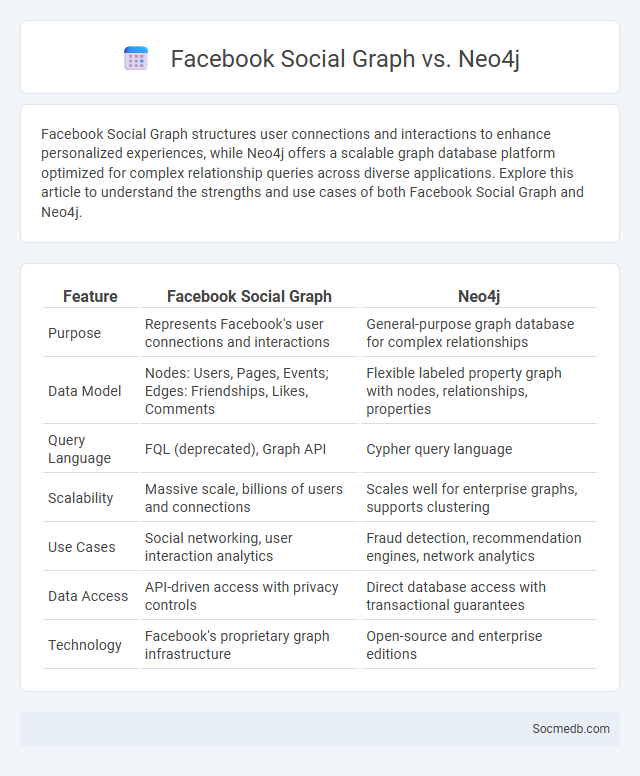
Photo illustration: Facebook Social Graph vs Neo4j
Facebook Social Graph structures user connections and interactions to enhance personalized experiences, while Neo4j offers a scalable graph database platform optimized for complex relationship queries across diverse applications. Explore this article to understand the strengths and use cases of both Facebook Social Graph and Neo4j.
Table of Comparison
| Feature | Facebook Social Graph | Neo4j |
|---|---|---|
| Purpose | Represents Facebook's user connections and interactions | General-purpose graph database for complex relationships |
| Data Model | Nodes: Users, Pages, Events; Edges: Friendships, Likes, Comments | Flexible labeled property graph with nodes, relationships, properties |
| Query Language | FQL (deprecated), Graph API | Cypher query language |
| Scalability | Massive scale, billions of users and connections | Scales well for enterprise graphs, supports clustering |
| Use Cases | Social networking, user interaction analytics | Fraud detection, recommendation engines, network analytics |
| Data Access | API-driven access with privacy controls | Direct database access with transactional guarantees |
| Technology | Facebook's proprietary graph infrastructure | Open-source and enterprise editions |
Introduction to Social Graphs
Social graphs represent the intricate network of relationships and interactions between individuals on social media platforms, mapping connections like friendships, followers, and shared interests. Understanding your social graph helps optimize content reach, engagement, and influence by identifying key nodes and communities. Leveraging this data enhances your ability to foster meaningful connections and grow your online presence effectively.
Understanding Facebook’s Social Graph
Facebook's Social Graph maps connections between people, pages, and interests, enabling personalized experiences based on your network interactions. It uses data points such as friendships, likes, comments, and shared content to create a rich web of relationships and preferences. Understanding this graph helps you optimize content reach, engagement, and targeted advertising on the platform.
What is Neo4j?
Neo4j is a powerful graph database designed to efficiently manage and analyze complex, interconnected data, making it ideal for social media platforms that rely on relationships between users, posts, and interactions. Your social media applications benefit from Neo4j's ability to quickly traverse social graphs, uncovering insights such as friend recommendations, user behavior patterns, and community detection. This graph-based technology enhances data connectivity and offers scalable performance for dynamic social network analysis.
Neo4j’s Approach to Social Graphs
Neo4j's approach to social graphs leverages its native graph database technology to map and analyze complex social networks with high efficiency and scalability. Your social media data can be represented as nodes and relationships, enabling real-time insights into user interactions, influencer identification, and community detection. This semantic-driven model empowers businesses to personalize content, improve recommendations, and foster deeper engagement.
Core Differences: Facebook Social Graph vs Neo4j
Facebook Social Graph primarily organizes user interactions and relationships through a proprietary, large-scale graph database designed for real-time social networking and content sharing. Neo4j leverages a labeled property graph model with customizable schemas, supporting complex queries and analytics via its Cypher query language, ideal for diverse graph-based applications beyond social networking. Core differences lie in Facebook's optimized infrastructure for massive user data integration versus Neo4j's flexible, developer-friendly platform for detailed graph data modeling and analysis.
Data Structures and Storage Methods
Social media platforms employ advanced data structures such as graphs to efficiently map user connections and interactions, facilitating real-time data retrieval and analysis. Storage methods often utilize distributed databases and NoSQL systems like Cassandra or MongoDB to manage vast volumes of unstructured data, ensuring scalability and fault tolerance. Optimized indexing and caching strategies contribute to faster access times and improved user experience across global networks.
Scalability and Performance Comparison
Social media platforms require robust scalability to handle millions of concurrent users and rapid content updates without downtime or lag. Performance comparison highlights that platforms leveraging distributed cloud infrastructure and edge computing achieve lower latency and higher throughput, enabling seamless user experiences even during traffic spikes. Efficient caching mechanisms and load balancing further enhance performance, ensuring fast content delivery and real-time interaction capabilities.
Use Cases: Facebook Social Graph vs Neo4j
Facebook Social Graph enables understanding of user connections and interactions at scale by representing billions of nodes and edges, making it ideal for personalized content recommendations and ad targeting. Neo4j, a leading graph database platform, excels in real-time relationship analysis, enabling dynamic friend suggestions, fraud detection, and knowledge discovery within social media ecosystems. The use cases differ as Facebook Social Graph integrates within Facebook's proprietary infrastructure for comprehensive social data insights, while Neo4j provides flexible, customizable graph solutions for external social media applications and enterprise-level analytics.
Security and Privacy Considerations
Social media platforms require robust security measures to protect user data from breaches, identity theft, and unauthorized access. Privacy considerations include encryption, user consent for data sharing, and transparent policies that comply with regulations like GDPR and CCPA. Implementing multi-factor authentication and regular privacy audits enhances safety and builds user trust in digital social environments.
Choosing the Right Social Graph Solution
Choosing the right social graph solution is essential for optimizing user connections and data relationships on your social media platform. Consider factors such as scalability, query performance, and data integration capabilities to ensure the solution supports complex network interactions efficiently. Your choice impacts user engagement and the accuracy of personalized content recommendations.
 socmedb.com
socmedb.com